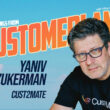A new recommendation model from MIT Sloan professor of operations management and operations research and statistics Georgia Perakis could help retailers see up to an 11% increase in profits.
by Meredith Somers
The model developed by Perakis and her co-researchers (her PhD students Lennart Baardman, PhD ’19, and Tamar Cohen-Hillel and Oracle collaborators Kiran Panchamgam and Setareh Borjian) calculates customer-to-customer trends — which are driven more and more by social media — and combined with retail data, recommends targeted promotions.
“Most purchases are able to create externalities whereby the sale to one customer affects other customers,” the paper states. “We need to measure these customer-to-customer trend effects before we can personalize prices and target promotions effectively.”
“We need to measure these customer-to-customer trend effects before we can personalize prices and target promotions effectively.”
In their paper “Detecting Customer Trends for Optimal Promotion Targeting,” the researchers explain that social interactions have always been important for creating trends, in part due to word-of-mouth, but now even more so with the growth of social media like Instagram and Twitter. That adds a new angle to a domain usually dominated by major marketing campaigns and, in some industries, celebrity culture.
“Nowadays, every person is able to create a social trend resulting in a change of the purchase behavior of their social connections,” the researchers write.
Social connections are a valuable source of marketing information, but that data is hard to collect because of privacy and cost issues. Even after retailers get a sense of a social network, the question then is how do they find the best marketing strategy to take advantage of those social connections — who is going to get a promotional offer on which item and when?
That’s why Perakis and her team set about finding a way “to detect customer relationships and estimate customer trends solely through transaction data that is readily available to the retailer.”
The paper’s publication is forthcoming in Manufacturing & Service Operations Management. The paper also received an honorable mention at the 2019 M&SOM Practice-Based Research Competition that took place in Singapore in July 2019.
Their promotion targeting recommendation model is based on a series of equations that begins with transaction and inventory data.
Data for the study was provided by Oracle, and came from a large fashion retailer that uses Oracle’s retail products. The anonymized company has around 635 stores across the United States and Puerto Rico, and the dataset uses information from a two-year period for 20 stores in Ohio.
“From the dataset, we know the number of customers in each group, the inventory of each item and location, the shipping cost, and the regular price of each item,” the researchers write. “Additionally, we compute the average promotion price that was used by the retailer for each item, and the number of promotions that were offered.”
Using those datasets, Perakis and her team calculated the various probabilities in which a group of customers (low, medium, and high spenders) purchasing clothes at one point in time might influence a separate group of customers to purchase the same clothing at a later date (and potentially create a trend).
The model for customer trends was then combined with promotion prices and restrictions — such as the budget in terms of numbers of promotions from the retailer — to determine the highest revenue potential for targeted promotions (which spending group receives a promotional price, and when).
Using their promotion recommendation model on transaction data from 20 Ohio stores, the team of researchers observed that compared to the retailer’s original marketing plan, revenue would go up 3-11% with an average revenue improvement of 7%.
“The demand model with customer trend and the optimization model for targeted promotions form a decision support tool for promotion planning,” the paper states. “Next to general planning, it also helps to find important customers and target them to generate additional sales.”
This article originally appeared in MIT Management Sloan School. Photo by Alex Perez on Unsplash.










